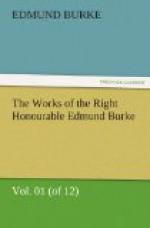and it is this idea of a common form that makes the
proportion of parts at all regarded, and not the operation
of any natural cause: indeed a little consideration
will make it appear, that it is not measure, but manner,
that creates all the beauty which belongs to shape.
What light do we borrow from these boasted proportions,
when we study ornamental design? It seems amazing
to me, that artists, if they were as well convinced
as they pretend to be, that proportion is a principal
cause of beauty, have not by them at all times accurate
measurements of all sorts of beautiful animals to
help them to proper proportions, when they would contrive
anything elegant; especially as they frequently assert
that it is from an observation of the beautiful in
nature they direct their practice. I know that
it has been said long since, and echoed backward and
forward from one writer to another a thousand times,
that the proportions of building have been taken from
those of the human body. To make this forced
analogy complete, they represent a man with his arms
raised and extended at full length, and then describe
a sort of square, as it is formed by passing lines
along the extremities of this strange figure.
But it appears very clearly to me that the human figure
never supplied the architect with any of his ideas.
For, in the first place, men are very rarely seen
in this strained posture; it is not natural to them;
neither is it at all becoming. Secondly, the view
of the human figure so disposed, does not naturally
suggest the idea of a square, but rather of a cross;
as that large space be tween the arms and the ground
must be filled with something before it can make anybody
think of a square. Thirdly, several buildings
are by no means of the form of that particular square,
which are notwithstanding planned by the best architects,
and produce an effect altogether as good, and perhaps
a better. And certainly nothing could he more
unaccountably whimsical, than for an architect to
model his performance by the human figure, since no
two things can have less resemblance or analogy, than
a man, and a house or temple: do we need to observe
that their purposes are entirely different? What
I am apt to suspect is this: that these analogies
were devised to give a credit to the works of art,
by showing a conformity between them and the noblest
works in nature; not that the latter served at all
to supply hints for the perfection of the former.
And I am the more fully convinced, that the patrons
of proportion have transferred their artificial ideas
to nature, and not borrowed from thence the proportions
they use in works of art; because in any discussion
of this subject they always quit as soon as possible
the open field of natural beauties, the animal and
vegetable kingdoms, and fortify themselves within
the artificial lines and angles of architecture.
For there is in mankind an unfortunate propensity to
make themselves, their views, and their works, the
measure of excellence in everything whatsoever.




